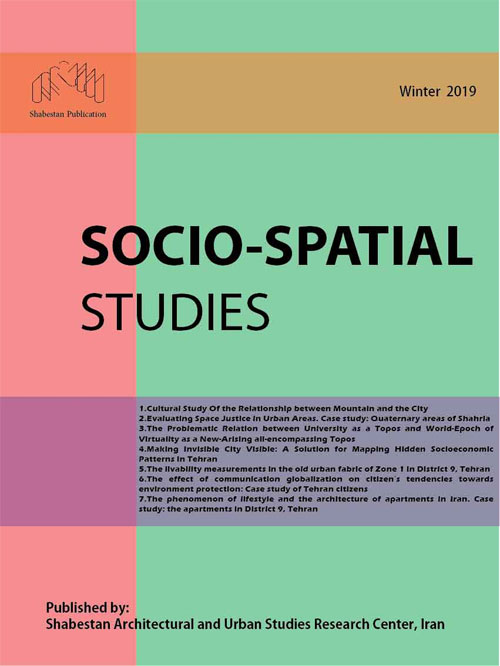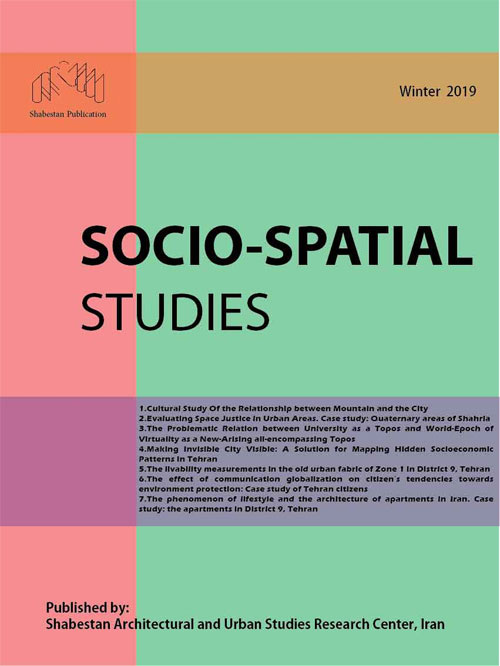فهرست مطالب

Journal of Socio Spatial Studies
Volume:3 Issue: 2, Spring 2019
- تاریخ انتشار: 1398/04/03
- تعداد عناوین: 7
-
Pages 1-8
The present study has been conducted with the objective of elaborating the cultural implications in the view of Tehran’s comprehensive development plan based on content analysis method. The study seeks finding an answer to the question as to how much does Tehran’s development vision plan include the cultural issues in the metropolitan setting? The realm of the current research is the entire contents of the second five-year development plan of Tehran’s municipality (2014-2018). The explicit and implicit themes indicating the culture-related issues have been separated and, considering their interrelationships, the explicit themes have been explored. The information gathering instrument was the content analysis checklist and its reliability was confirmed by external auditors based on convergence coefficient in the course of coding. The results indicated that a considerable part of Tehran’s development plan is directed at modern morphological and structural elements, urban requirements, civil development and urban control and supervision policies and supervision and a lower deal of attention has been paid to the cultural, hypothetical and soft topics. These findings show that Tehran is still trapped in physicalist development and expanding culture decline.
Keywords: Religion, Modern Society, metropolis-dwelling, physicalism, cultural decline -
Pages 9-20
In the modern cities, various issues show up. One of them is consumption which is deeply interlaced with modernity as the city’s prevalent culture in its sociological sense. Amongst the most important manifestations of consumption in the today’s cities is the consumption of the elements that are applied by the assistance of urban policies and parallel to the beautification of the public spaces and called aesthetical elements’ consumption in the current article. It is now for a while that Tehran has offered different urban aesthetical elements in the public spaces. Considering the necessity of recognizing the extent to which urban aesthetical elements are consumed as well as their interrelationships with the individuals’ citizenship identity, the present article evaluates the urban cultural policies through a survey research in three neighborhoods in Tehran, namely Niavaran, Jannat Abad and Yaft Abad. The study sample volume includes 390 individuals from the foresaid three neighborhoods to whom a questionnaire was administered as the data collection instrument. In the end, the results indicated that there is a significant relationship between the consumption of urban aesthetical elements’ consumption and citizens’ identities. The interpretation of the form of this relationship allows the researchers evaluate the effectiveness of the urban cultural policies. The results of this evaluation have been offered in the conclusion section of the current research paper.
Keywords: Cultural Consumption, urban aesthetics, aesthetical elements’ consumption, citizenship identity, Tehran -
Pages 21-29The present article tries discovering and reflecting the environmental challenges and issues of the urban space. The various urban communities are faced with different types of environmental-urban issues and this is per se in need of common solutions. Issues like water and land are currently being frequently seen especially in the cities of the developing countries. Similarly, the supply of the citizens’ financial needs is amongst the challenges increasingly reflected and manifested in the urban communities. The emergence of a set of urban challenges would be per se followed by novel and newly emerging issues. Considering the increase in the city dwelling population, these spots need new management and adoption of effective plans and policies. Following the increase in the world’s population since the second half of the twentieth century on and following the change in the population’s lifestyle, particularly the city-dwellers, these citizens have encountered new and unprecedented challenges and any hesitation in responding to their needs would be per se accompanied by new and more problems for them. During the three past centuries, the city’s health and comfortability have been largely jeopardized. The qualitative and quantitative changes in the city’s population during the era after industrial revolution rendered the cities themselves vulnerable from various respects in such a way that various organizations have to be coherently in search of a cure and solution to such problems. While only sixteen cities worldwide had populations above one million people until 1900, the number of cities with multi-million populations has increased since then and this has per se directly influenced the ascending trend of the urban challenges. Although there are numerous urban challenges, environmental problems are more widely observed than the other bottlenecks.Keywords: Environmental Challenges, land, water, Lifestyle, Industrial Revolution, multi-million populated cities
-
Pages 30-39It would be much of value and importance to understand how in less than a century after the attack to another land and nation, the uncultured invaders changed dramatically in the realm of science and knowledge so they created an academic complex, Rab'-e Rashidi, during Ilkhanid dynasty. Rab'-e Rashidi as a big academic center was established by Rashid-al-Din Fadhlollah Hamadani (the minister of Ghazan Khan) in the late 7th century (the 13th century). According to his Report, this complex was equipped with a paper factory, a library, an educational treatment center (Dar-ol-Shafa), a center for teaching and researching on Quran (Dar-ol Quran), accommodation for teachers and students, and other facilities. Thousands of students from Iran, China, Egypt, and Syria studied their desired subjects there. In addition to the components of the foundation, it contained caravanserais, shops, baths, storehouses, mills, and so on. Though, the Rab'-e Rashidi began to decline after the death of Rashid al-Din in 1318 and during its long history much damage happened by human causes or by natural disasters, but from the viewpoint of sociology of knowledge, it is very important that Rashid-al-Din Fadhlollah Hamadani performed different rules and regulations for all of these aspects and constituents, in detail: Vaghfnameh is an elaborating and professorial book written by Hamadani which describe Rab'-e Rashidi complex. Findings indicates that Rab'-e established according to an existential state of human in the world and describes a system of justice.Keywords: Rab'-e Rashidi, Rashid-al-Din Fadhlollah Hamadani, Ilkhanid dynasty, educational, administrative structure
-
Pages 40-47According to Gibson, the affordances of everything, material or nonmaterial, constitute part of its assets making it usable to a certain creature or a member of creatures’ species. The affordances of an artificial environment (social environment herein) restrict or increase the behavioral choices according to the environment’s structure. In other words, every environment can play a considerable role in the enhancement and improvement and/or reduction of behavior. The present study seeks to find the factors influencing the increase in the affordance of an environment. The study has been conducted based on a descriptive-analytical method. The investigation of the first-hand resources, library documents and observations account for a notable quotient of the study goals’ advancement. In the end, the results show that the creation of factors like the supply of physical needs, attachment to a place, memorability, sociability of the spaces, legibility in the attachments to a place and contribution to the growth of the social environment affordances is influential.
-
Pages 48-60
Today, the quality and quantity of urban spaces has become one of the most important developmental indicators in the cities. The management of citizenship relations and increase of social interactions level and presence of people in urban spaces have been considered as the backbone and capital of a dynamic and vibrant community. The purpose of this study was to determine and evaluate the effective indicators on promoting social interactions in urban spaces with a happy city approach. Sampling method was determined by multi-stage comparative stratified sampling and the number of samples was determined by using Cochran formula about 384 people in Qaemshahr. Data collection tool was a research hypothesis questionnaire. Descriptive statistics were used to describe the data. Inferential statistics were used to analyze the hypotheses by SPSS and LISREL software. Four effective factors for promoting social interactions were extracted. These factors are as follows: the first priority is the sense of belonging to the place (5.10), the second priority is security (3.95), the third priority is the urban pedestrian (3.67) and the fourth priority was urban furniture (3.60). The results show that all the components affect the promotion of social interactions in the city's public spaces.
-
Pages 61-80Turbulence and inconsistency of urban physical system in the physical structure of Iran contemporary cities is one of the instances of identity crisis; the weakness of the educational system in the faculties of architecture and urban planning, the promotion of foreign culture in the domestic press, the weakness of the infrastructures of native culture education, the interference of experts from other scientific fields in architecture and urban planning, the weakness of urban management strategies, high expense housing and the necessity to supply housing for the needy people have created a turbulent city with eclectic culture and it made the native culture less prominent than before. The present research introduced the concept of “urban architecture”. The main presupposition of research is that the architecture of monuments in the historical texture has sufficient capabilities in the quality of physical structure of city and architects concurrently paid attention to the architectural characteristics of monuments and urban space quality. The purpose of present research is that to investigate the effective architectural factors to improve the social life of urban spaces thus the research question is that “how to architect while constructing architectural structures to shape an urban space with social quality?” The necessity of the study is the role of urban spaces to shape the social life and the significance of the study is the possibility to clarify a “bottom-up” design procedure to consider the concept of “urban architecture”, and also to institutionalize qualifications for urban spaces through architectures. The present qualitative research has been conducted with the logical argumentation and causal- interpretative strategies and through documentary- field study in the case study of Abyaneh village. Research findings, while paying attention to the qualitative components of urban spaces resulting from monuments architecture, have proposed strategies to realize the concept of “urban architecture” consistent with the components of social sustainability.Keywords: Urban Architecture, Urban Space, Historical texture, Islamic architecture, Islamic city, Abyaneh


